Design of Event-Triggered Fault-Tolerant Control for Stochastic Systems with Time-Delays
Abstract
:1. Introduction
2. Problem Statement
- 1:
- When , the system is exponentially mean-square stable.
- 2:
- Under the zero-initial conditionfor all nonzero , where , and a is prescribed scalar.
3. Main Results
3.1. Event-Triggered Control Based on State Information
| Algorithm 1 Design procedure for solving the problem of Theorem 1 |
3.2. Event-Triggered Control Based on Send-on-Delta Strategy
4. Results and Discussion
4.1. Example 1
4.2. Example 2
5. Conclusions
Author Contributions
Funding
Acknowledgments
Conflicts of Interest
Abbreviations
| LD | linear dichroism |
| IOT | Internet of things |
| LMIs | linear matrix inequalities |
References
- Zhang, X.M.; Han, Q.L. Network-based H∞ filtering using a logic jumping-like trigger. Automatica 2013, 49, 1428–1435. [Google Scholar] [CrossRef]
- Zhang, B.L.; Han, Q.L.; Zhang, X.M. Recent advances in vibration control of offshore platforms. Nonlinear Dyn. 2017, 89, 755–771. [Google Scholar] [CrossRef]
- Zhao, G.; Guo, J.; Qiang, H. Research on SFLA-based bidirectional coordinated control strategy for EV battery swapping station. Comput. Mater. Contin. 2017, 53, 343–356. [Google Scholar]
- Cao, Z.Z.; Du, F.; Xu, P. Control mechanism of surface subsidence and overburden movement in backfilling mining based on laminated plate theory. Comput. Mater. Contin. 2017, 53, 175–186. [Google Scholar]
- Li, Y.J.; Wu, Q.E.; Peng, L. Simultaneous Event-Triggered Fault Detection and Estimation for Stochastic Systems Subject to Deception Attacks. Sensors 2018, 18, 321. [Google Scholar] [CrossRef] [PubMed]
- Selivanov, A.; Fridman, E. Event-triggered H∞ control: A switching approach. IEEE Trans. Autom. Control 2016, 61, 3221–3226. [Google Scholar] [CrossRef]
- Khashooei, B.A.; Antunes, D.J.; Heemels, W.P.M.H. Output-based event-triggered control with performance guarantees. IEEE Trans. Autom. Control 2017, 62, 3646–3652. [Google Scholar] [CrossRef]
- Jury, E.I.; Mullin, F.J. The analysis of sampled-data control systems with a periodically time-varying sampling rate. IRE Trans. Autom. Control 1959, 4, 15–21. [Google Scholar] [CrossRef]
- Miskowicz, M. Event-Based Control and Signal Processing; CRC Press: Boca Raton, FL, USA, 2016. [Google Scholar]
- Åström, K.J.; Bernhardsson, B. Comparison of periodic and event based sampling for first-order stochastic systems. In Proceedings of the 14th IFAC World Congress, Cape Town, South Africa, 24–29 August 1999; pp. 301–306. [Google Scholar]
- Donkers, M.C.F.; Heemels, W.P.M.H. Output-based event-triggered control with guaranteed L∞-gain and improved and decentralized event-triggering. IEEE Trans. Autom. Control 2012, 57, 1362–1376. [Google Scholar] [CrossRef]
- Ramesh, C.; Sandberg, H.; Johansson, K.H. Performance analysis of a network of event-based systems. IEEE Trans. Autom. Control 2016, 61, 3568–3573. [Google Scholar] [CrossRef]
- Zhang, X.M.; Han, Q.L.; Zhang, B.L. An Overview and Deep Investigation on Sampled-Data-Based Event-Triggered Control and Filtering for Networked Systems. IEEE Trans. Ind. Inf. 2017, 13, 4–16. [Google Scholar] [CrossRef]
- Acho, L. Event-Driven Observer-Based Smart-Sensors for Output Feedback Control of Linear Systems. Sensors 2017, 17, 2028. [Google Scholar] [CrossRef] [PubMed]
- Socas, R.; Dormido, S.; Dormido, R.; Fabregas, E. Event-based control strategy for mobile robots in wireless environments. Sensors 2015, 15, 30076–30092. [Google Scholar] [CrossRef] [PubMed]
- Putra, I.P.E.S.; Brusey, J.; Gaura, E.; Vesilo, R. An Event-Triggered Machine Learning Approach for Accelerometer-Based Fall Detection. Sensors 2018, 18, 20. [Google Scholar] [CrossRef] [PubMed]
- Xu, Z.Z.; Liu, G.L.; Yan, H.T.; Cheng, B.; Lin, F.L. Trail-Based Search for Efficient Event Report to Mobile Actors in Wireless Sensor and Actor Networks. Sensors 2017, 17, 2468. [Google Scholar] [CrossRef] [PubMed]
- Santos, C.; Martinez-Rey, M.; Espinosa, F.; Gardel, A.; Santiso, E. Event-Based Sensing and Control for Remote Robot Guidance: An Experimental Case. Sensors 2017, 17, 2034. [Google Scholar] [CrossRef] [PubMed]
- Miskowicz, M. Send-on-delta concept: An event-based data reporting strategy. Sensors 2006, 6, 49–63. [Google Scholar] [CrossRef]
- Diaz-Cacho, M.; Delgado, E.; Barreiro, A.; Falcon, P. Basic Send-on-Delta Sampling for Signal Tracking-Error Reduction. Sensors 2017, 17, 312. [Google Scholar] [CrossRef] [PubMed]
- Wang, B.C.; Meng, X.Y.; Chen, T.W. Event based pulse-modulated control of linear stochastic systems. IEEE Trans. Autom. Control 2014, 59, 2144–2150. [Google Scholar] [CrossRef]
- Wu, L.G.; Gao, Y.B.; Liu, J.X.; Liu, H.Y. Event-triggered sliding mode control of stochastic systems via output feedback. Automatical 2017, 82, 79–92. [Google Scholar] [CrossRef]
- Albattat, A.; Gruenwald, B.C.; Yucelen, T. On Event-Triggered Adaptive Architectures for Decentralized and Distributed Control of Large-Scale Modular Systems. Sensors 2016, 16, 1297. [Google Scholar] [CrossRef] [PubMed]
- Li, H.P.; Shi, Y. Event-triggered robust model predictive control of continuous-time nonlinear systems. Automatical 2014, 50, 1507–1513. [Google Scholar] [CrossRef]
- Wang, X.F.; Lemmon, M.D. Event-triggering in distributed networked control systems. IEEE Trans. Autom. Control 2011, 56, 586–601. [Google Scholar] [CrossRef]
- Hu, S.; Yin, X.; Zhang, Y.; Tian, E.G. Event-triggered guaranteed cost control for uncertain discrete-time networked control systems with time-varying transmission delays. IET Control Theory Appl. 2012, 6, 2793–2804. [Google Scholar] [CrossRef]
- Guo, X.F.; Ren, X.M.; Li, Z.J.; Han, C.W. Fault detection and fault-tolerant control over signal-to-noise ratio constrained channels. Int. J. Robust Nonlinear Control 2018, 28, 2806–2827. [Google Scholar] [CrossRef]
- Zeng, Y.L.; Xu, L.; Chen, Z.D. Fault-Tolerant Algorithms for Connectivity Restoration in Wireless Sensor Networks. Sensors 2016, 16, 3. [Google Scholar] [CrossRef] [PubMed]
- Xiahou, K.S.; Wu, Q.H. Fault-tolerant control of doubly-fed induction generators under voltage and current sensor faults. Int. J. Electr. Power Energy Syst. 2018, 98, 48–61. [Google Scholar] [CrossRef]
- Wang, Z.D.; Yang, F.W.; Ho, W.D.C.; Liu, X.H. H∞ robust filtering for stochastic time-Delay systems with missing measurements. IEEE Trans. Signal Process. 2006, 54, 2579–2587. [Google Scholar] [CrossRef]
- Cogill, R.; Lall, S.; Hespanha, J.P. A constant factor approximation algorithm for event-based sampling. In Proceedings of the 2007 American Control Conference, New York, NY, USA, 11–13 July 2007; pp. 305–311. [Google Scholar]
- Oya, H.; Hagino, K.; Kayo, S. Adaptive robust control based on piecewise Lyapunov functions for a class of uncertain linear systems. In Proceedings of the European Control Conference 2007, Kos, Greece, 2–5 July 2007; pp. 810–815. [Google Scholar]
- Yang, F.W.; Wang, Z.D.; Hung, Y.S.; Gani, M. H∞ control for networked systems with random communication delays. IEEE Trans. Autom. Control 2006, 53, 511–518. [Google Scholar] [CrossRef]
- Gao, H.; Lam, J.; Wang, C.; Wang, Y. Delay-dependent output-feedback stabilisation of discrete-time systems with time-varying state delay. IEE Proc.-Control Theory Appl. 2004, 151, 691–698. [Google Scholar] [CrossRef]
- Shi, D.W.; Chen, T.W.; Shi, L. Event-triggered maximum likelihood state estimation. Automatica 2014, 50, 247–254. [Google Scholar] [CrossRef]
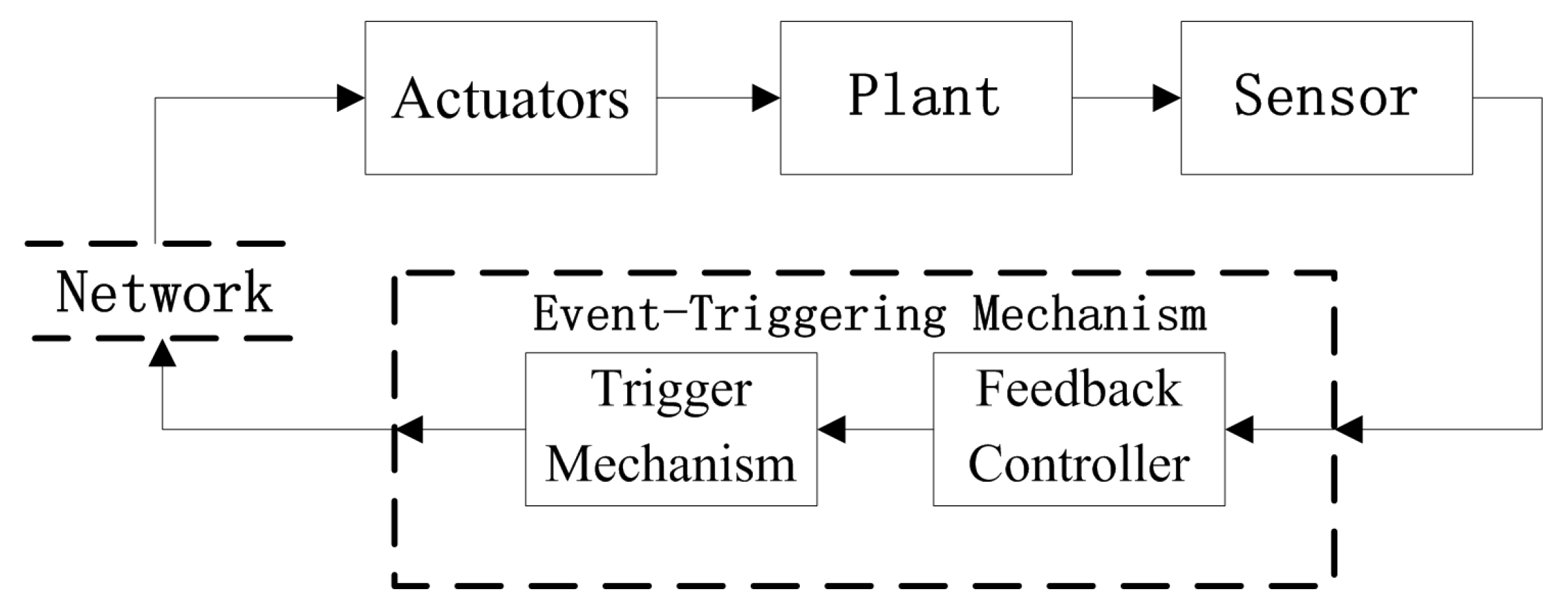
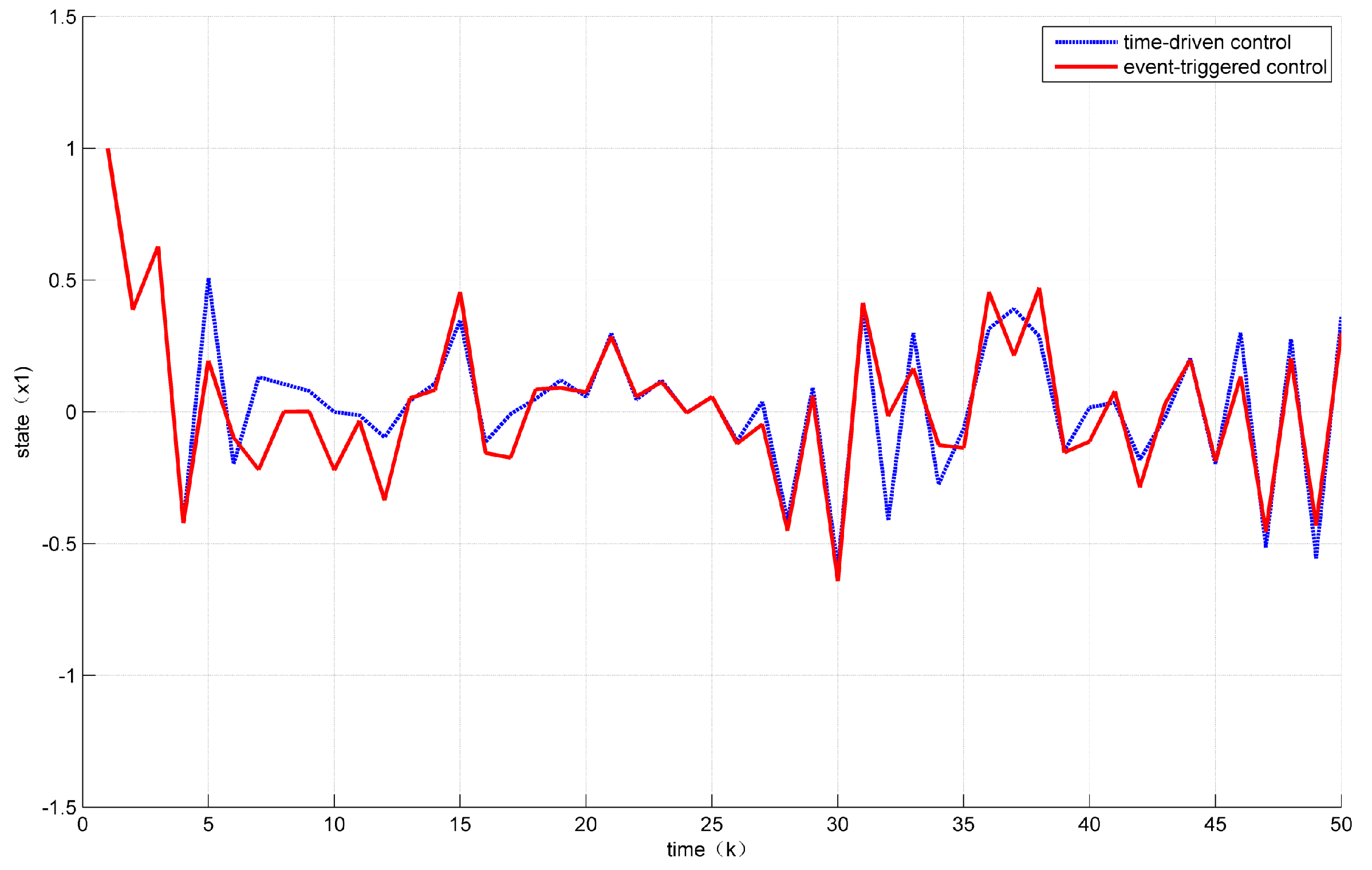
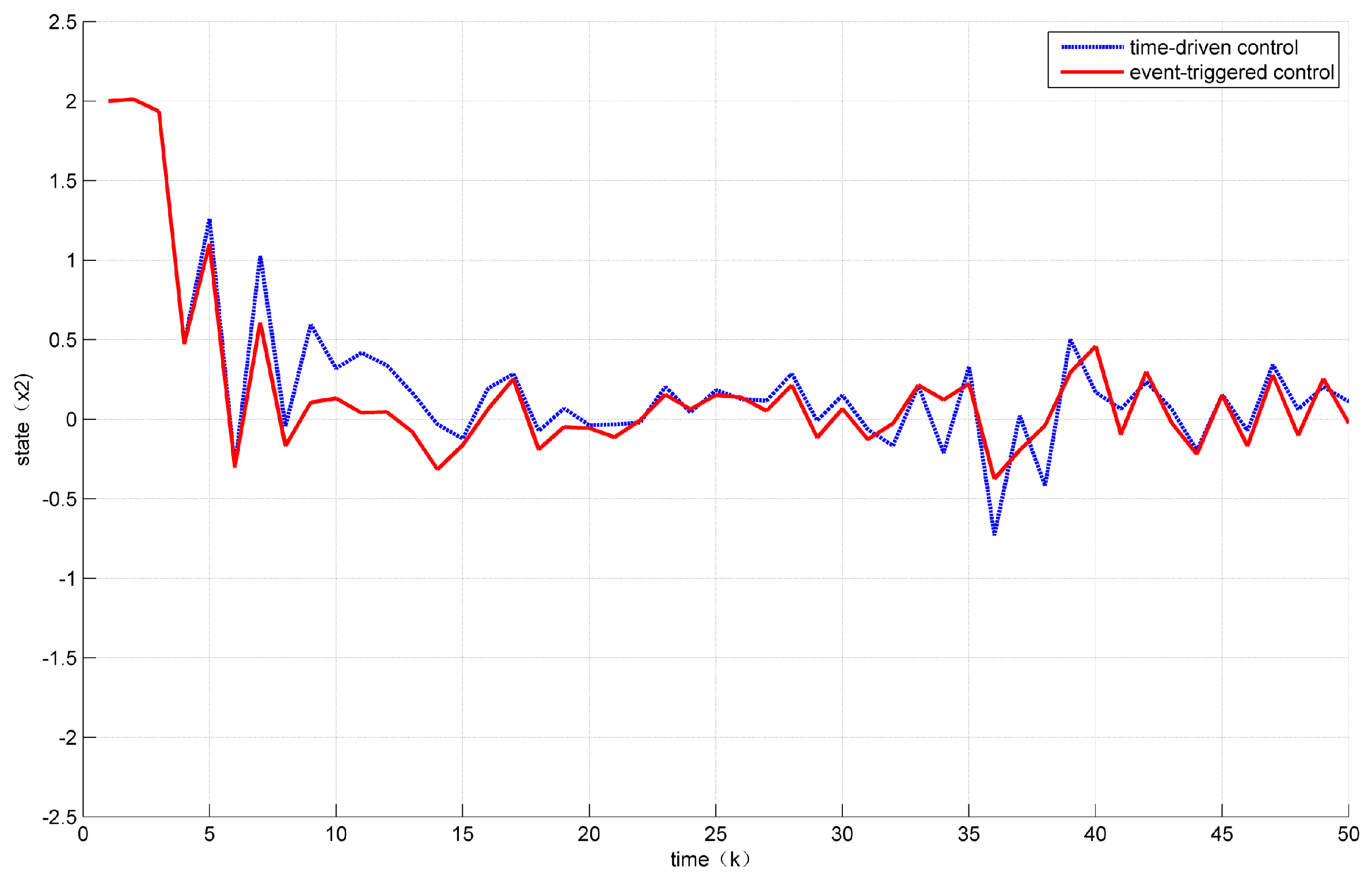
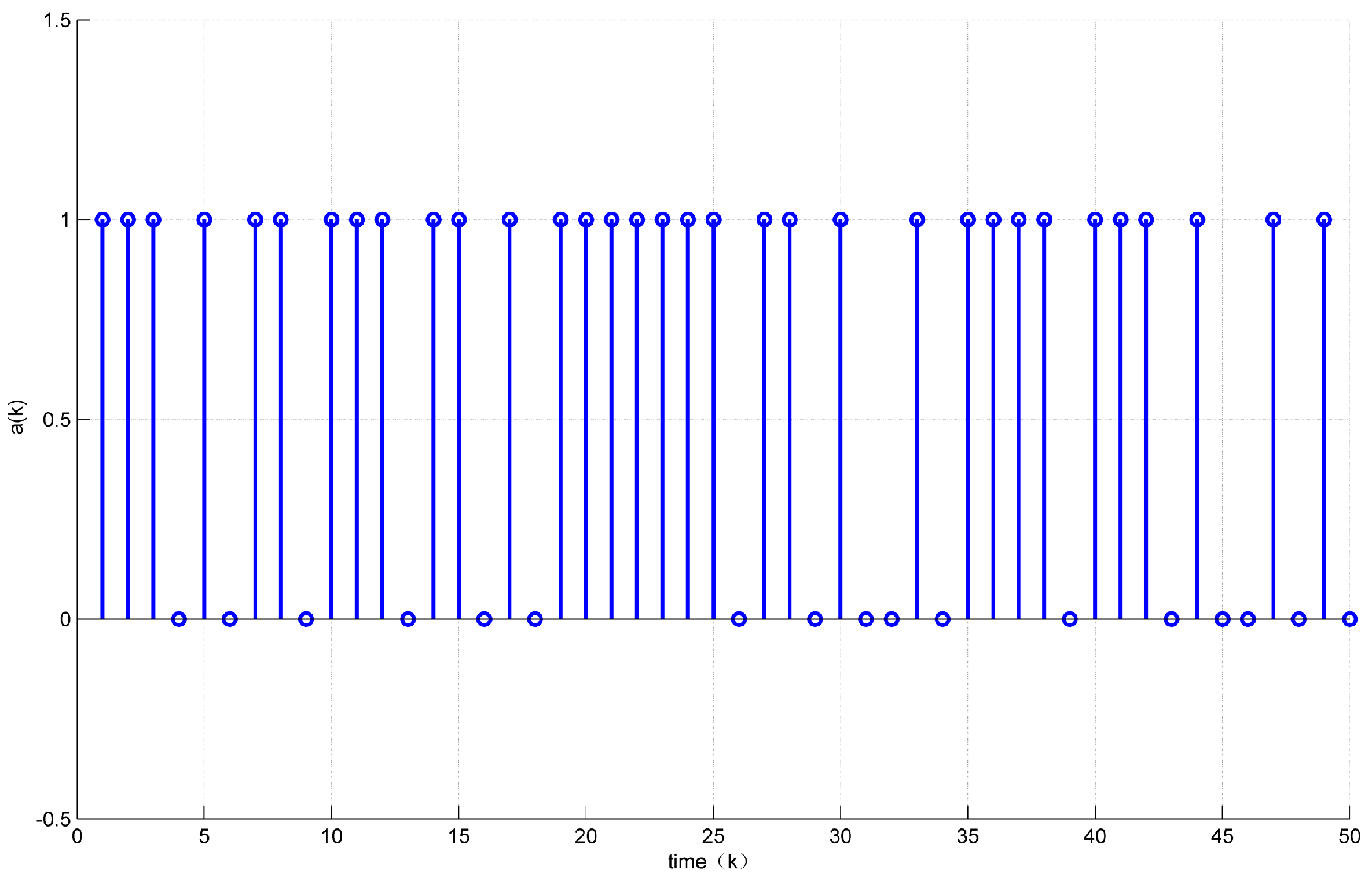
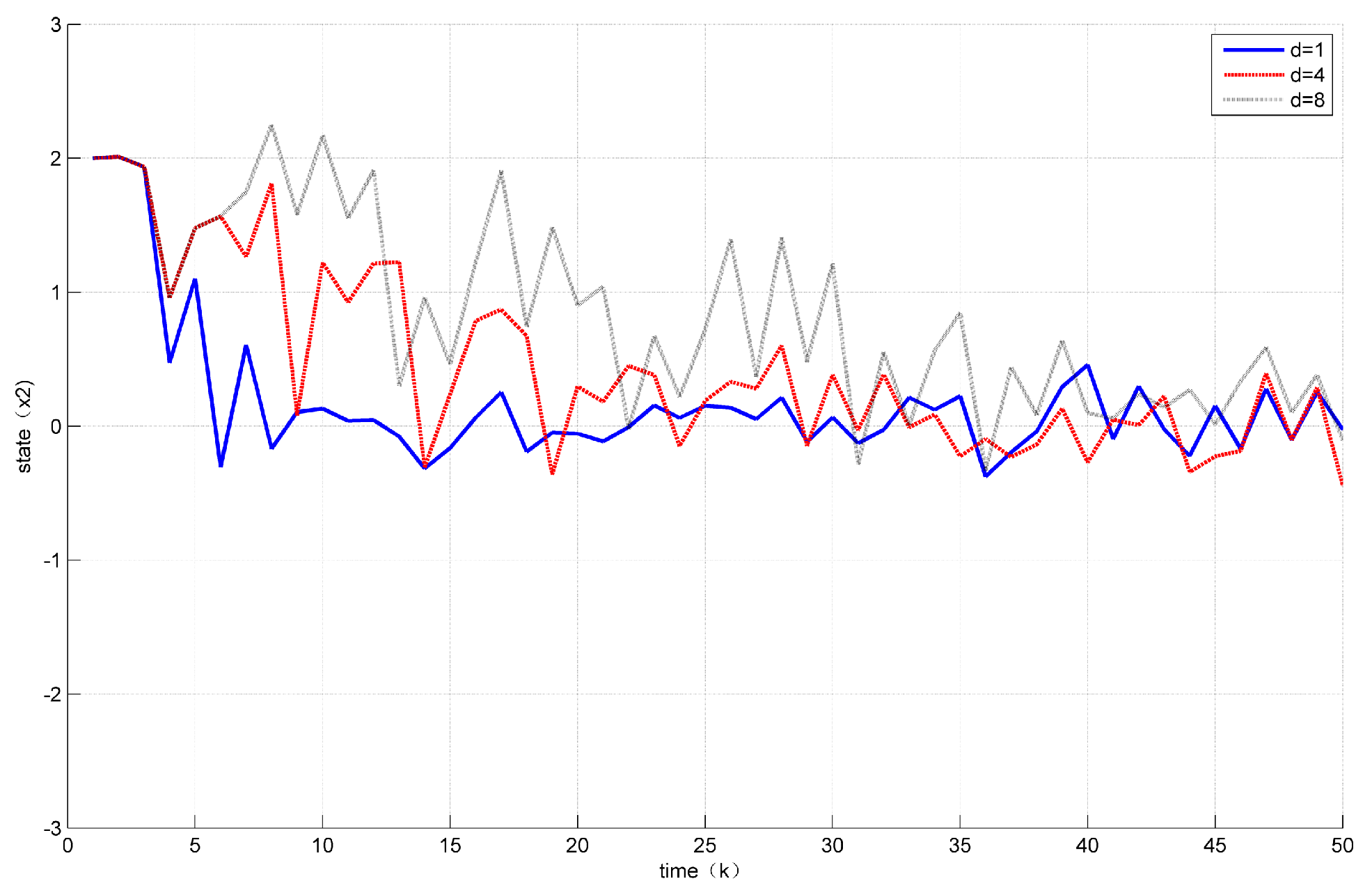
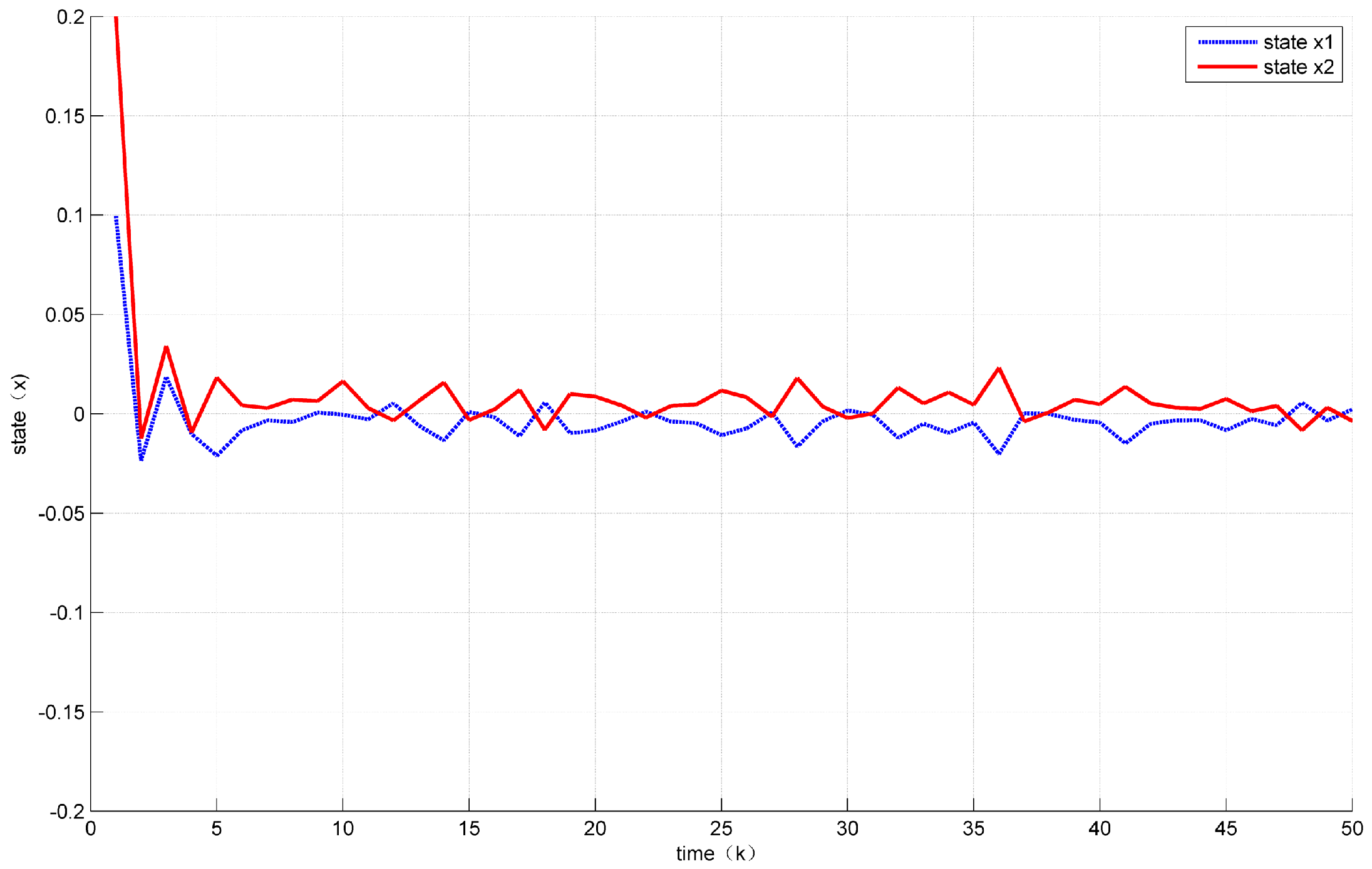
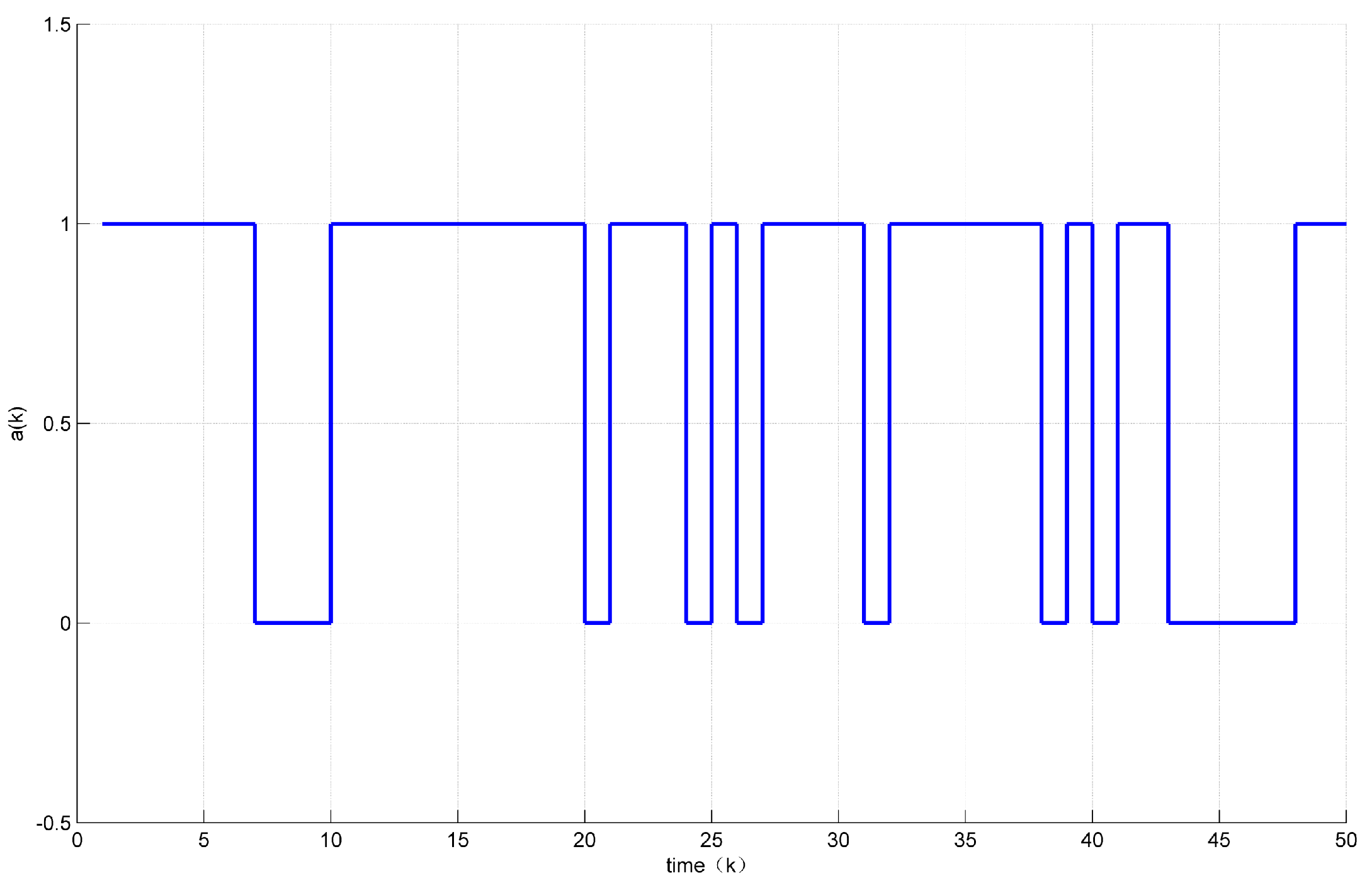
| Time Delays | |||
|---|---|---|---|
| Trigger Times | 33 | 40 | 45 |
© 2018 by the authors. Licensee MDPI, Basel, Switzerland. This article is an open access article distributed under the terms and conditions of the Creative Commons Attribution (CC BY) license (http://creativecommons.org/licenses/by/4.0/).
Share and Cite
Gao, Y.; Li, Y.; Peng, L.; Liu, J. Design of Event-Triggered Fault-Tolerant Control for Stochastic Systems with Time-Delays. Sensors 2018, 18, 1929. https://doi.org/10.3390/s18061929
Gao Y, Li Y, Peng L, Liu J. Design of Event-Triggered Fault-Tolerant Control for Stochastic Systems with Time-Delays. Sensors. 2018; 18(6):1929. https://doi.org/10.3390/s18061929
Chicago/Turabian StyleGao, Yi, YunJi Li, Li Peng, and Junyu Liu. 2018. "Design of Event-Triggered Fault-Tolerant Control for Stochastic Systems with Time-Delays" Sensors 18, no. 6: 1929. https://doi.org/10.3390/s18061929
APA StyleGao, Y., Li, Y., Peng, L., & Liu, J. (2018). Design of Event-Triggered Fault-Tolerant Control for Stochastic Systems with Time-Delays. Sensors, 18(6), 1929. https://doi.org/10.3390/s18061929





